1893 – 1915

‘A’ Company 4th Battalion The Royal Sussex Regiment
Remembered at
Helles Memorial Turkey panel 125,
Worthing World War I Memorial,
& The Chapel of St. George in Chichester Cathedral
(the Memorial Chapel of The Royal Sussex Regiment)
This is a very sad and terrible story.
Harold Edward Briggs, my great uncle, was born of George Herbert and Edith Matilda Briggs of 50, Sugden Road, Worthing, Sussex where they lived from at least 1915 to 1950 when Edith died. In all they had 9 children, 6 girls and 3 boys. One of the girls was Florence, my grandmother and mother of my father, Leslie.
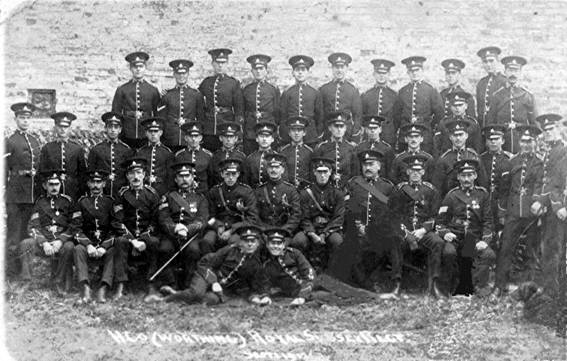
Harold was enlisted into the British army on the 8th November 1910 at the age of 17. He received his military training in the Sussex Downs, Patcham and at Newhaven. At the time of his death he was serving in ‘A’ Company, 4th Battalion, The Royal Sussex Regiment which I believe was infantry. He had a brother named Percival (Percy) J. Briggs who was enlisted into the same Company, Battalion and Regiment on the 24th April 1913 as Pte. No.1677. Percy was to survive the Great War
After Turkey had entered World War I on the side of the Central Powers on the 29th October 1914 it was first considered possible to force Turkey out of the war and secure a sea passage through the Dardanelles which is a narrow sea way at the western end of Turkey, from the Aegean Sea leading to the Black Sea and Russia. This would open communication with our ally Russia by means of purely a naval bombardment that commenced on the 15th February 1915. When it became evident that this attempt was doomed to failure, it was abandoned in favour of a combined naval and military operation in which an army was to land at the Gallipoli Peninsula of Turkey which is on the north west coast next to the Dardanelles channel supported by the guns of the allied fleets. Thus begun the Gallipoli Campaign.
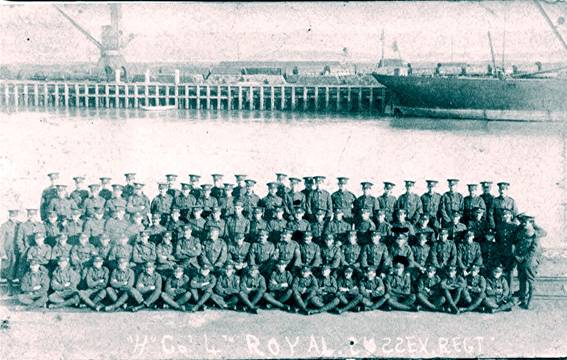
I visited Worthing Public reference library to inspect volumes of the history of The Royal Sussex Regiment and chose from them references of files and documents held at West Sussex Public Record office at Chichester. I was to make 7 visits to Chichester and examined rewritten copies of the official regimental war diary (the original having become lost during the campaign), regimental records, soldiers’ letters home, local and national newspaper cuttings of which there were many, correspondence and notes and a few photographs and a postcard; all relating to the 4th Battalion. I also was able to inspect two military maps of Gallipoli Peninsular that had been produced at the Survey department in Egypt in 1915, and obtained a copy of one of them.
I was able to meet my second cousin, Elsie Ellis who still lives in Worthing. Elsie was born in 1917, a daughter of Edith who was a sister of Harold and Percy. She was able to supply me with information and some military photographs showing both Harold and Percy in uniform. With Elsie, I visited the memorial chapel of The Royal Sussex Regiment in Chichester Cathedral where on St., Georges Day the 23rd April each year a service is held. A candle is lit every Friday throughout the year and each day a page is turned in the Book of Remembrance.
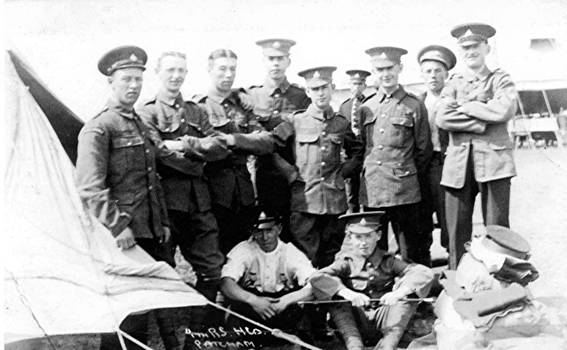
One photograph (seen left) was taken at Patcham, Sussex in 1913. Harold Briggs is seen in the back row second from the left.
In 1915 the men of ‘A’ Company came from Cuckfield, Haywards Heath and Worthing. They were lead by Captain J.R. Warren and overall command of the 4th Battalion was by Lieutenant Colonel W.R. Campion M.P.,
The journey for the soldiers of the 4th Battalion began on the 16th July 1915 from Bedford departing for Devonport aboard two trains where they arrived the following day. They boarded HMT Ulysses of 14,499 tons and left Devonport on the 17th July 1915 for Alexandia, Egypt in the Mediterranean Sea where they arrived on 28th July. They left Alexandia on 30th and arrived at Port Said the following day where some of the Battalion disembarked for duties in Egypt and I expect Gaza and Palestine where the Turks were probably already present. The ship then departed Port Said on the 4th August and arrived on the 7th at Mudros Bay on the Greek island of Limnos in the Aegean Sea where the allies had a large base.
HMT Ulysses then sailed for Imbros, another Greek island at that time, and on 8th August arrived the same day at 2.00 p.m. and at 6.15 p.m. left for Suvla Bay which is at the end off the Gallipoli Peninsula, again arriving on the same day.
At Suvla Bay the Battalion then disembarked, the last barge leaving at 11.45 p.m. On the 9th at 4.15 a.m. the Battalion moved away from ‘C’ Beach to construct a trench running southeast from Hill 63 (105 L/7) At 6.00 a.m. they moved to Lala Baba. At 11.00 a.m. the Battalion were ordered to moved to Hill 53 and came under shell fire for the first time on crossing ground south of Salt Lake, see map. At 1.00 p.m still on the 9th the troops were ordered to take 100 rounds of extra ammunition each and move up to support the left of the 33rd Brigade which was falling back. The Battalion advanced to the attack, the objective to take Hill 70 (105 1/9) and support The Queen’s Regiment. At 3.30 p.m. the attack had reach the line – no troops on our left— the Battalion was unable to hold the advanced position and the Commanding Officer gave orders to hold the line of Turkish trenches about 105 B/9 – H3; at 4.15 p.m. the trenches were occupied—- enemy pressing our left and some difficulty was experienced to maintain the line. At 11.20 p.m. the Commanding Officer was able to report that the Battalion was in touch with The Lincoln Regiment on the right and The Cheshire Regiment on the left. Owing to the scattered formation of the Battalion at the end of the day the fighting strength was reduced to 250, the casualties recorded at the time were, 1 Officer killed and 3 wounded, Other Ranks 11 killed and 60 wounded. The losses were much greater than this, remember, it took 2 trains to transport the 4th Battalion from Bedford to Devonport. I believe the original strength of the Battalion was between 800 to 900 hundred.
10th August 1915. The Battalion was ordered to hold the trenches whilst the 53rd Division attacked; if the attack was successful the Battalion was to follow up. No other War Diary entries for this day were made so I expect the 53rd did not succeed. This was the day that the death of Pte. Briggs was recorded although he was officially listed as missing.
11th August 1915. The Battalion left the trenches——- and the Battalion reformed behind the right on its line about 105 H/2. This was the only entry for the 11th.
12th August 1915. Battalion relieved by the Yorkshire and Lancashire Regiments and moved to the beach to rejoin the 160th Infantry Brigade. This is the only entry of the 12th.
14th to 18th August 1915. Work on trenches. This is the only War Dairy entry of this period.
During September, October and November the remains of the 4th Battalion of The Royal Sussex Regiment are on the beach area carrying out fatigues, general work and having rest periods. Came under howitzer shelling on the 25th September. More men join the Battalion from time to time to build back its strength.
Evacuation
13th December 1915. Embark on the ‘Elkahira’ to Mudros harbour. The main evacuation took place around the 20th December and was very successfully carried out with hardly any losses. A great deal of stores and munitions that had accumulated were left behind and it was only when they were set afire did the Turks realize that the evacuation had taken place.
19th December 1915. Arrive back at Alexandria.
The strength of the Battalion on the 31st January 1916 was recorded as 19 Officers and 316 Other Ranks and on 30th June 1916, 39 Officers and 887 Other Ranks. This meant that the Battalion had been gradually brought back up to something like normal strength.
From December 1915 to March 1917 the 4th Battalion moved around Egypt and Gaza and Palestine as well doing endless training and repairs to important facilities such as rail heads. Action against the Turks around Gaza resumed on the 26th March1917 through to May 1917. Fierce actions were short lived, a few days at most, thereafter action was occasional and light although fierce action in November 1915 did take place.
30th-31st December 1917. The War Diary records “Enemy found to have retired from our front” Which I feel was the Battalion’s only real success in all this time.
The records of the Battalion during its service at Suvla Bay were lost in transit to Alexandia or sometime before and all efforts to find them failed, so the records I inspected at the Public Records Office at Chichester were those that had been rewritten later and from memory. I think this is the reason the War Diary records are found to conflict with letters written at the time that were sent home and published, apparently unedited in the newspapers. Many of the newspapers articles reporting the Gallipoli Campaign make it sound as if all is going well when really it was a disaster, perhaps too early for it to be accepted and realised just how bad things were going.
From letters written by soldiers of the 4th Battalion that found their way into local newspapers I obtained extra information. On Monday the 9th August 1915, which was the first day of action for the 4th Battalion, there was a strong north wind and the Turks lit scrub fires, which then burnt south to the Battalions lines. This would have made life even more difficult for our soldiers who were already suffering from the terrible heat of a Turkish high summer. They could in no way be expected to be use to this heat. Turkish soldiers moved forward in twos and threes. They had blue uniforms that contrasted against the black burnt scrub; some scrub had not been burnt and remained green. However, some of our soldiers on higher ground could look down and clearly see the advancing groups of Turkish soldiers amongst the burnt and green scrub, they were able to use their rifles to pick them off. Some of the higher ground we occupied was known as Chocolate Hill that had been taken from the Turks by the Irish. Due to the heat much drinking water was needed. The wells were marked by Turkish snipers who knew where the wells were located. Our metal helmets seem to offer little protection from bullets but at least helped to keep the sun off.
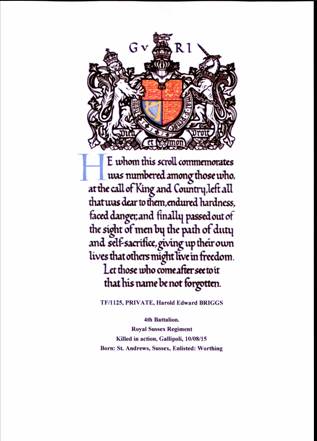
On Tuesday the 10th August 1915 the Official War Diary has only one entry, which simply said “the 4th were to hold the trenches……….” but from the reports sent home and published in the press there was plenty of action. This is the day Pte. Briggs was killed but I still do not know how. Was he wounded on the 9th and died on the 10th? Was he killed by a Turkish sniper or their very effective machine guns, which killed so many, or from artillery fire? I expect now, I will never know. As Harold was officially listed as missing I feel he may probably have been killed by artillery fire.
On the 9th August the 4th Battalion was 750 strong, at the end on this day the War Diary put it at 250 but recorded only and total of 12 killed and 63 injured for both Officers and all Other Ranks. Such must have been the chaos that the true figures at the time were impossible to know.
From the letters written home the three main problems were lack of water, the heat of the day and flies. With so many dead lying around the flies were the only real winners of this awful conflict. In contrast the nights were very cold. Often correspondence written home ridiculed the Turks. Throughout August the ‘Sussex Daily News’ remained upbeat and not able to accept the truth. The press reflected the great courage and bravery being shown and how we were making life difficult for the Turks, which indeed we were but we were not brought up to manage in such high day times temperatures as they were.
The allied troops were made up from many nations, Britain, France, India, Senegal and in particular Australia and New Zealand, the latter being remembered as the ANZACS. Despite our large military resources, naval support and extensive efforts the Gallipoli Campaign failed in the face of the magnificent Turkish defence of their country. We lost several war ships due to Turkish mines.
What was happening at home?
Ship after ship brought the wounded home and the hospitals filled. Many people at home began to help. They raised money for the wounded and donations of medical supplies poured in such as sheets, slippers, bandages, wheelchairs etc., Three to four thousand eggs a week were donated from our area for the hospitals. Ladies set up ‘War Work Rooms’ where among other tasks they embroidered badges for The Royal Sussex Regiment. Parcels were created for our prisoners abroad. They must have been shocked by so many wounded, some terribly. Now the newspapers could not be so upbeat and the truth was painfully being realized. Each newspaper, each week or even daily listed the dead and wounded.
The Cost1
The eight month campaign lasted from April to December 1915 with evacuation of the Gallipoli Peninsula completed on the 9th January 1916. On the 11th December 1915 the allied casualties were officially published: -
25,000 Dead
12,000 Missing
75,000 Wounded
96,000 Hospital Sickness and Accident Admissions
Another source records that 410,000 British troops were committed to the expedition and causalities amounted to a total of 214,000.2
Turkish losses during a five day period in June 1915 were estimated at 20,000 killed and prisoners taken and for this same month the allies one way or the other lost nearly 50,000.3 Another source records that the Turks officially recorded a total of 215,000 casualties but is thought to be much higher.4
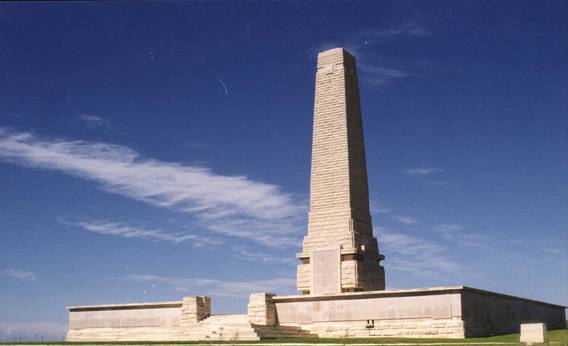
There are five memorials on the Gallipoli Peninsular. The Helles Memorial stands on the tip of the Gallipoli Peninsula. It takes the form of an obelisk over 30 metres high that can be seen by ships passing through the Dardanelles. This is the Memorial on which Pte Briggs is recorded.
What is the ultimate answer to prevent all wars ? I wish I knew.
It appears to me that in this campaign nothing was achieved and all was a wasted effort although the Turks pulled out of the Middle East at the end of 1917. Whatever the number of Turkish casualties it is said that the flower of the Turkish army had been crushed and the risks to us had been reduced in the forthcoming Palestinian Campaign.
The evacuations were praised for an orderly and excellent operation with only three wounded, plus some brilliant military manoeuvres leading to successful advances but these could not be held nor achieved further. Had I been there I am sure I would not have survived.
The following poem is taken from a printed black and white postcard posted home by Pte. Ernest George Richardson of Streat, Hassocks, Sussex ‘B’ Company 4th Battalion The Royal Sussex Regiment, killed in action at Soissons, France 29th July 1918 age 26, also served at Gallipoli.
Dreams of Home and You
Now the restless day is ending and the shadows around me fall.
Homeward, where is enshrined my all
And I think about you often.
Fearing not what luck may bring
If the home I’m guarding ’s guarded and You’re right. That’s everything.
Signed Wander
There is a Turkish story too.
© Graham L. Boots
21st November 2003
My thanks go to:
WSCC Archive Chichester and the Public Reference Library,Worthing, West Sussex.
Mrs Elsie Ellis who was able to supply me with information and copies of photographs for which I am extremely grateful.
- The British Encyclopedia Illustrated. Published by Odhams Press Limited London 1933. General Editorship J.M. Parish, M.A. (Oxon.) & Others. Volume 5. ⏎
- The Great Battles of World War I. Author Jack Wren. Published by The Hamlyn Publishing Group Limited London. Second Impression 1974 ISBN 0 600 33903 3 ⏎
- The British Encyclopedia Illustrated. Published by Odhams Press Limited London 1933. General Editorship J.M. Parish, M.A. (Oxon.) & Others. Volume 5. ⏎
- The Great Battles of World War I. Author Jack Wren. Published by The Hamlyn Publishing Group Limited London. Second Impression 1974 ISBN 0 600 33903 3 ⏎






